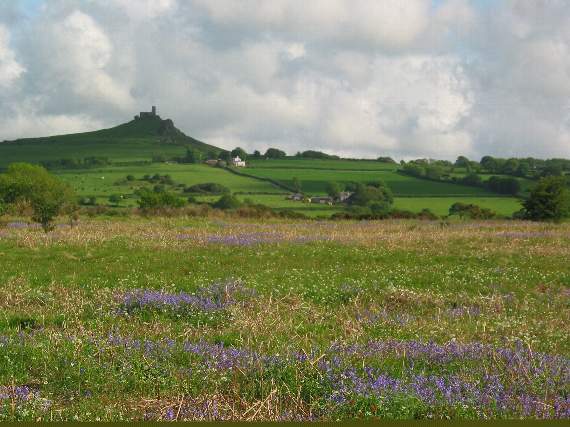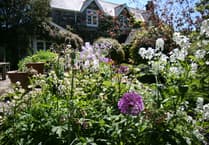Shannon Hards talks to the Brentor Commons Association who are restoring a wildlife haven to its former glory.
FROM rare insects to ancient tracks and mine shafts, little-known Bowden Down and Liddaton Down, near Brentor, are home to magical scenes to thrill any wildlife enthusiast, right on your doorstep.
Over the past 11 years, despite growing financial struggles, the Brentor Commons Association (BCA), who took on the land in 2005, have been gradually restoring the commons to its former glory.
The freehold for Bowden Down and Liddaton Down was purchased by the Brentor Commons Trust (BCT) in June 2004, with the help of a grant from the Dartmoor Preservation Association, but in 2005, responsibility for the land was passed on to the BCA.
The BCA has 28 members and owns 42 acres of common land in the parish of Brentor. It is a registered charity and manages the only example of lowland heath in West Devon.
Local resident and land manager for the BCA, Will Walker-Smith said that despite being ten minutes outside Tavistock, and offering some of the best sloes and blackberries in West Devon, many locals have never visited the commons.
He added: ‘In simple terms we see the land in four separate quadrants, a butterfly conservation, wildlife area, one area is bracken manage-ment, one is just full of bluebells and the other is a wooded area.
‘Around 20 people own the commons and nine or ten people have commoner’s rights — those people are farmers who own the land nearby and can come onto the land and take wood and stone and graze their animals but they don’t pay much attention to the common land apart from maybe using it as a shortcut.’
Bowden Down is made up of 28.2 acres of fairly level, degraded lowland heath, cut into two segments by a north-south road. It was the site of mining for manganese and ochre in the 19th century and the remnants of mining shafts and open cast workings remain. The western quadrant offers a fine display of bluebells in the spring and has remnants of the original heather cover. It is an excellent location for watching cuckoos in the spring and small pearl bordered fritillaries and pearl bordered fritillaries have also been recorded.
Liddaton Down, slightly smaller, at 16.1 acres is an area of rough uneven land, 500m west of Bowden Down. The land slopes steeply down to a stream in the south and towards the Lyd Valley in the north. There are three small quarries in the south-east segment, the largest of which is flooded and is known as Liddaton Pond. The northwest segment has a two acre bluebell meadow.
The BCA have members from all walks of life, ranging from the former director of the Marine Biological Association in Plymouth to a physics teacher turned guitar tutor.
Will Walker-Smith said: ‘I was a landscaper/builder and in my other life I was a psychiatric social worker and team manager for Adult Services in West Devon.
‘My wife was a health visitor and worked in public health in Plymouth. We also have a librarian, computer software designer, medical secretary and finance adviser... We are now retired of course! We also have Dr Belinda Wheeler who is an ecologist and advises us on many aspects of the work that we can and can’t do – she is not retired. We also have local people who just chipped in when we were trying to buy the land.’
Will added: ‘There are so many historical features to the commons. On the northern edge of Bowden Down there is an ancient hollow way, that used to be the M1 of the area! People would use the track to travel and let their cattle graze on the common, which is why there are deliberate ditches, called oxbowls, all over the area, they were put in to gather rain water that the cattle would drink.
‘The farmers that let their animals graze really helped the land. The animals were hefted (a traditional method of managing flocks or herds on large areas of common land and communal grazing) which meant they stayed on the land and kept the bracken down.’
Will said the farmers stopped grazing their animals on the commons in the late 80s and despite having researched ways to get animals back, the association have had to stick to organic ways of clearing the land.
He added: ‘We looked into getting cattle grids installed but we would need eight and they would cost around £20,000 each – so that is not going to happen!
‘The bracken comes in June — we don’t cut it or use any chemicals. We have a bracken roller which is used to flatten out the bracken without cutting it. It bruises the plant and that weakens the root, if we cut it the root would grow more. The way we do it reduces nutrients in the soil which stops it growing — it is interesting to see what grows under the bracken once we have reduced the nutrients in the soil. We only use the bracken roller in late summer and autumn when the birds have finished nesting — the last thing we want to do is to harm the wildlife.’
Sarah Walker-Smith, Will’s wife and also a member of the association said that the group protect the rare plants and wildlife on the commons as much as possible.
She added: ‘We have limited heather in the commons so we protect the few patches we have left very well, if anyone goes near it we make sure it isn’t harmed! There is such varied wildlife, when you walk around you never know what you are going to see — we often find Barry, our chairman, up here at various hours of the day bird watching. No one else has ever really known what to do with the land so it wasn’t very expensive when we bought it.’
Will added: ‘Our chairman also writes for the village newsletter to raise awareness of the group and the commons. Hardly anyone knows about the quarry pond as it is covered with plants! We had been looking into getting some interpretation boards for years and Plymouth Unversity made an information board for us but have struggled with funds so haven’t been able to afford to put any up.
‘We get a grant of around £500 a year from Defra (Department for Environment, Food and Rural Affairs) and we obviously don’t make any money. People are quite generous often giving us the odd £20 but that doesn’t go very far. Insurance is very expensive – if we hold working parties we need to insure the people working and we need public liability insurance for people walking through the commons.’
Dr Mike Whitfield, secretary of The Brentor Commons Association and former director of the Marine Biological Association in Plymouth, said: ‘One of our forms of income is from telegraph poles! We get paid £1 per year per pole and in total that equals around £70. I think funding is one of our biggest problems and will get worse. I am part of the village archive and that used to attract support but it doesn’t anymore. Our funds will ultimately run out, the Defra grant has kept us running so far. We have to deal with incidents of fly-tipping and sometimes pay for removal. We also have mine shafts which are starting to subside so will have to fence them.’
Will added: ‘There are steep drops and we also have a 120ft mine shaft but to fence off mines we have to raise permission as it’s common land. We also had to get money to do the fencing and get trained people to put in the fences – we actually put an advert in the Times to alert people about our application for the fencing.’
Will said that despite financial difficulties, the association has been able to maintain the area, run surveys and educational events because of grants from various organisations.
He added: ‘Devon County Council gave us the money to do a biological survey on a rare mud snail and diving beetle – the quarry pond has an extremely rare habitat and the pond itself disappears in the summer.
‘Local artist Jennie Hale has also worked with us on educational events held in her yurt as a workshop under the sky. We had a grant from Dartmoor National Park Authority to run three events with local primary schools. Jennie showed the children how to set gentle traps so they could see the animals and draw them. We also had scientists talk to the children and a man from a tinker family, who took wood straight out of the common and made things in front of the children. We try to use the common to get grants for teaching and education.
‘We have also been lucky to receive lots of help from working parties. We had a group of post graduates come to help us and they would go out on the wettest, winter days no matter what! We have also had help from people with special needs and refugees – we would love it if local people helped us with a working party.’
Mike said that the recent fly-tipping incident at Liddaton Pond, featured in the Times, was particularly hard to tackle because of the little financial help they receive.
Will added: ‘We were particularly angry about the fly-tipping because we only get £500 from Defra and don’t want to use that to pay removal costs for someone else’s rubbish!
‘There is some rubble on Liddaton Down, that was fly-tipped, which has been there for nine or ten years, we forget it is there though because plants grow around it and it gets hidden. We also have some daffodils near the quarry pond, they aren’t wild ones though, they are standard and are probably a result of someone fly-tipping — it is unusual, we get strange signs of fly-tipping. I worry now because I read in the Times that West Devon Borough Council is thinking about charging for garden waste collection — that will only make matters worse!’
Despite damage caused by incidents of fly-tipping, Bowden and Liddaton Down are teaming with fascinating wildlife — a host of birds and insects can be seen and heard from even the very edges of the commons.
Will said: ‘This area is such a great place for watching voles run through and we also get barn owls, tawny owls and lots of varieties of butterfly.’
Mike added: ‘I hope we get a nice spring and a warm June because the butterfly don’t settle for long and they stay low to the ground so it can be hard to spot them.’
Will said that the association also believed they have dormice but needed someone with a license to trap one to look at it because they are an endangered species.
He added: ‘We have nine species of bats, maybe more and lizards, adders and grass snakes. Yellow hammers are often in the commons and we saw lots of cuckoos before they started to become a bit scarcer.
‘We recently had 480 trees from the Woodland Trust as part of the Queen’s 90th birthday celebrations — including an oak tree from Balmoral. Mike uses GPS signal to plot where each tree is planted – we have a range of birch, oak and hawthorn. Many of the other trees have self seeded so I can walk through and think wow there is another tree, I haven’t seen that one before! All sorts of things grow up naturally in the quarry. It’s funny because we made a conscious decision to let some areas overgrow to protect the wildlife!
‘Our bluebells are much later this year because of the cold spells we have had but I hope they will appear in a couple of weeks!’
Will said the group has plans for the future and would like to get more local people involved.
He added: ‘What we would like to do is develop a mosaic of the different landscapes. The land is fascinating but it takes a lot of management — as you can see we are an ageing group held together by replacement parts!
‘We would love to see people use the area and walk through it but also need people to help us clear it – if people want more walking paths, we can make them but we need help!’



.jpeg?width=209&height=140&crop=209:145,smart&quality=75)
-with-lightning).jpeg?width=209&height=140&crop=209:145,smart&quality=75)
Comments
This article has no comments yet. Be the first to leave a comment.